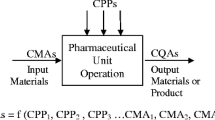Abstract
ICH Q8(R2) established general guidelines around the Relationship of a Design Space to Scale and Equipment (Section 2.4.4); however, the guideline is not intended to provide guidance on scientific strategy for the application and implementation. It is widely recognized that drug product processes are typically scale and equipment sensitive; however, the same expectation should not be applied broadly to drug substance processes due to fundamental difference between the disciplines. This paper proposes a scientific perspective and strategy of how to develop design spaces that include scale and equipment knowledge for drug substance processes, and how to use that knowledge to mitigate the risk when changing from laboratory thorough commercial facilities.




Similar content being viewed by others
Notes
(a) http://www.ich.org/cache/compo/276-254-1.html. (b) Continuum of Criticality is a concept introduced by ISPE’s criticality team (to be published). Presented by Tim Watson and Roger Nosal at Pharmaceutical Technology, CBI Research Inc Conference, Philadelphia PA USA, August 11, 2009.
Supply chain flexibility is especially vital in the early years of commercialization since market projections are not particularly predictive of future API demand. Thus, in order to sustain the supply chain, particularly for products that exceed prediction, this requires the ability to change batch sizes, equipment trains, and sometimes sizes very rapidly.
Currently, implementing low-risk as well as high-risk scale and equipment changes requires regulatory submissions in the approved markets. These post-approval submissions have agency-specific requirements, different review period, and application costs. The longest review period for a major change is 18 months to 2 years, and the global filing expenses can approach one million dollars.
Steady state is when the processing conditions (i.e., material flow rates, temperature, and/or pressure) are within normal processing variations, and the processing conditions do not significantly change with time. Steady state may also be when the process controls are at the pre-determined, desired set points (for example, a reactor temperature set point) and there are only normal process variations.
This paper, along with case studies, is scheduled for presentation at the AIChE annual meeting in Nashville TN, USA in November of 2009 by Tim Watson.
References
Watson TJN, Nosal R, am Ende D, Bronk K, Mustakis J, O’Connor G, et al. Journal of Pharmaceutical Innovation. 2007;2(3-4):71.
Lepore J, Spavins J. Journal of Pharmaceutical Innovation. 2008;3(2):79.
Caygill, Graham, Zanfir M, Gavriilidis A. Scalable reactor design for pharmaceuticals and fine chemicals production. 1: Potential scaleup obstacles. Org Process Res Dev. 2006;10:539–52.
Muller HL, Latimer JM. Anticipation of scale up issues in pharmaceutical development. Comput Chem Eng. 2008;33:1051–5. doi:10.1016/j.compchemeng.2008.09.015.
Bourne JR. Organic Process R&D. 2003;7:471–508.
Connors KA. Chemical kinetics. New York: Wiley-VCH; 1990.
Baldyga J, Bourne JR. Turbulent mixing and chemical reactions. New York: Wiley; 1999.
Baldyga, Bourne JR, Walker B. Non-isothermal micromixing in turbulent liquids: theory and experiment. Can J Chem Eng. 1998;76:641.
Mueller M, Meier U, Wieckhusen D, Beck R, Pfeffer-Hennig S, Schneeberger R. Cryst Growth Des. 2006;6(4):946–54.
Wieckhusen D. Process chemistry in the pharmaceutical industry, pp 295–312. Boca Raton: CRC; 2008.
Nichols. J Pharmaceutical Engineering. 2008;28(5):24.
Author information
Authors and Affiliations
Corresponding author
Rights and permissions
About this article
Cite this article
am Ende, D.J., Seymour, C.B. & Watson, T.J.N. A Science and Risk Based Proposal for Understanding Scale and Equipment Dependencies of Small Molecule Drug Substance Manufacturing Processes. J Pharm Innov 5, 72–78 (2010). https://doi.org/10.1007/s12247-010-9083-1
Published:
Issue Date:
DOI: https://doi.org/10.1007/s12247-010-9083-1




